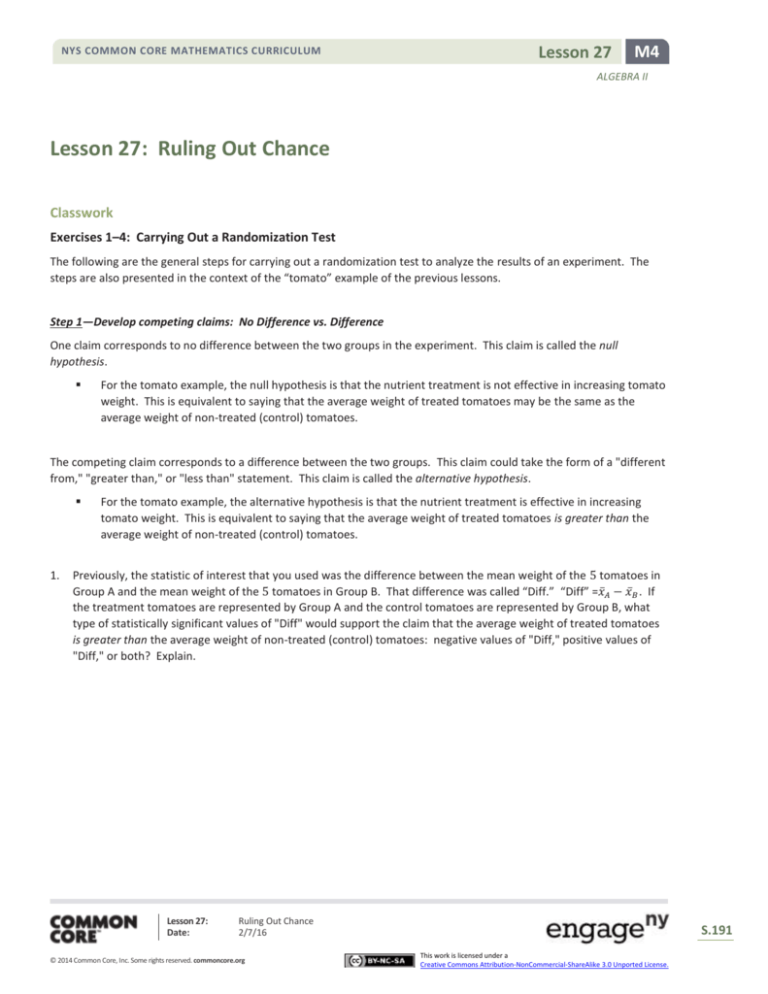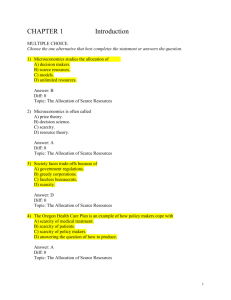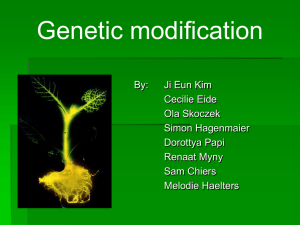
NYS COMMON CORE MATHEMATICS CURRICULUM
Lesson 27
M4
ALGEBRA II
Lesson 27: Ruling Out Chance
Classwork
Exercises 1–4: Carrying Out a Randomization Test
The following are the general steps for carrying out a randomization test to analyze the results of an experiment. The
steps are also presented in the context of the “tomato” example of the previous lessons.
Step 1—Develop competing claims: No Difference vs. Difference
One claim corresponds to no difference between the two groups in the experiment. This claim is called the null
hypothesis.
For the tomato example, the null hypothesis is that the nutrient treatment is not effective in increasing tomato
weight. This is equivalent to saying that the average weight of treated tomatoes may be the same as the
average weight of non-treated (control) tomatoes.
The competing claim corresponds to a difference between the two groups. This claim could take the form of a "different
from," "greater than," or "less than" statement. This claim is called the alternative hypothesis.
1.
For the tomato example, the alternative hypothesis is that the nutrient treatment is effective in increasing
tomato weight. This is equivalent to saying that the average weight of treated tomatoes is greater than the
average weight of non-treated (control) tomatoes.
Previously, the statistic of interest that you used was the difference between the mean weight of the 5 tomatoes in
Group A and the mean weight of the 5 tomatoes in Group B. That difference was called “Diff.” “Diff” =𝑥̅𝐴 − 𝑥̅𝐵 . If
the treatment tomatoes are represented by Group A and the control tomatoes are represented by Group B, what
type of statistically significant values of "Diff" would support the claim that the average weight of treated tomatoes
is greater than the average weight of non-treated (control) tomatoes: negative values of "Diff," positive values of
"Diff," or both? Explain.
Lesson 27:
Date:
Ruling Out Chance
2/7/16
© 2014 Common Core, Inc. Some rights reserved. commoncore.org
S.191
This work is licensed under a
Creative Commons Attribution-NonCommercial-ShareAlike 3.0 Unported License.
Lesson 27
NYS COMMON CORE MATHEMATICS CURRICULUM
M4
ALGEBRA II
Step 2—Take measurements from each group, and calculate the value of the “Diff” statistic from the experiment.
For the tomato example, first measure the weights of the 5 tomatoes from the treatment group (Group A); next,
measure the weights of the 5 tomatoes from the control group (Group B); finally, compute “Diff” =𝑥̅𝐴 − 𝑥̅𝐵 , which will
serve as the result from your experiment.
2.
Assume that the following represents the two groups of tomatoes from the actual experiment. Calculate the value
̅𝑨 − 𝒙
̅𝑩 . This will serve as the result from your experiment.
of “Diff” =𝒙
These are the same 10 tomatoes used in previous lessons; the identification of which tomatoes are "treatment" vs.
"control" is now revealed.
TREATMENT
CONTROL
Group A
Group B
9.1
7.7
8.4
6.4
8.0
5.2
7.3
4.4
5.9
3.8
Again, these tomatoes represent the actual result from your experiment. You will now create the randomization
distribution by making repeated random assignments of these 10 tomatoes into 2 groups and recording the observed
difference in means for each random assignment. This develops a randomization distribution of the many possible
difference values that could occur under the assumption that there is no difference between the mean weights of
tomatoes that receive the treatment and tomatoes that don’t receive the treatment.
Lesson 27:
Date:
Ruling Out Chance
2/7/16
© 2014 Common Core, Inc. Some rights reserved. commoncore.org
S.192
This work is licensed under a
Creative Commons Attribution-NonCommercial-ShareAlike 3.0 Unported License.
Lesson 27
NYS COMMON CORE MATHEMATICS CURRICULUM
M4
ALGEBRA II
Step 3–Randomly assign the observations to two groups, and calculate the difference between the group means.
Repeat this several times, recording each difference. This will create the randomization distribution for the "Diff"
statistic.
Examples of this technique were presented in a previous lesson. For the tomato example, the randomization
distribution has already been presented in a previous lesson and is shown again here. The dots are placed at increments
of 0.04 ounces.
Step 4—With reference to the randomization distribution (Step 3) and the inequality in your alternative hypothesis
(Step 1), compute the probability of getting a "Diff" value as extreme as or more extreme than the "Diff" value you
obtained in your experiment (Step 2).
For the tomato example, since the treatment group is Group A, the "Diff" value of 𝑥̅𝐴 − 𝑥̅𝐵 is 𝑥̅ 𝑇𝑟𝑒𝑎𝑡𝑚𝑒𝑛𝑡 − 𝑥̅𝐶𝑜𝑛𝑡𝑟𝑜𝑙 .
Since the alternative claim is supported by 𝑥̅ 𝑇𝑟𝑒𝑎𝑡𝑚𝑒𝑛𝑡 > 𝑥̅𝐶𝑜𝑛𝑡𝑟𝑜𝑙 , you are seeking statistically significant "Diff" values
that are positive since if 𝑥̅ 𝑇𝑟𝑒𝑎𝑡𝑚𝑒𝑛𝑡 > 𝑥̅𝐶𝑜𝑛𝑡𝑟𝑜𝑙 , then 𝑥̅ 𝑇𝑟𝑒𝑎𝑡𝑚𝑒𝑛𝑡 − 𝑥̅𝐶𝑜𝑛𝑡𝑟𝑜𝑙 > 0 .
Statistically significant values of "Diff" that are negative, in this case, would imply that the treatment made the tomatoes
smaller on average.
3.
Using your calculation from Exercise 2, determine the probability of getting a "Diff" value as extreme as or more
extreme than the "Diff" value you obtained for this experiment (in Step 2).
Step 5—Make a conclusion in context based on the probability calculation (Step 4).
If there is a small probability of obtaining a "Diff" value as extreme as or more extreme than the "Diff" value you
obtained in your experiment, then the "Diff" value from the experiment is unusual and not typical of chance behavior.
Your experiment's results probably did not happen by chance, and the results probably occurred because of a
statistically significant difference in the two groups.
In the tomato experiment, if you think there is a statistically significant difference in the two groups, you have
evidence that the treatment may in fact be yielding heavier tomatoes on average.
Lesson 27:
Date:
Ruling Out Chance
2/7/16
© 2014 Common Core, Inc. Some rights reserved. commoncore.org
S.193
This work is licensed under a
Creative Commons Attribution-NonCommercial-ShareAlike 3.0 Unported License.
NYS COMMON CORE MATHEMATICS CURRICULUM
Lesson 27
M4
ALGEBRA II
If there is not a small probability of obtaining a "Diff" value as extreme as or more extreme than the "Diff" value you
obtained in your experiment, then your "Diff" value from the experiment is NOT considered unusual and could be
typical of chance behavior. The experiment's results may have just happened by chance and not because of a
statistically significant difference in the two groups.
In the tomato experiment, if you don't think that there is a statistically significant difference in the two groups,
then you do not have evidence that the treatment results in larger tomatoes on average.
In some cases, a specific cut-off value called a significance level might be employed to assist in determining how small
this probability must be in order to consider results statistically significant.
4.
Based on your probability calculation in Exercise 3, do the data from the tomato experiment support the claim that
the treatment yields heavier tomatoes on average? Explain.
Exercises 5–10: Developing the Randomization Distribution
Although you are familiar with how a randomization distribution is created in the tomato example, the randomization
distribution was provided for you. In this exercise, you will develop two randomization distributions based on the same
group of 10 tomatoes. One distribution will be developed by hand and will contain the results of at least 250 random
assignments. The second distribution will be developed using technology and will contain the results of at least 250
random assignments. Once the two distributions have been developed, you will be asked to compare the distributions
Manually Generated
Your instructor will provide you with specific guidance regarding how many random assignments you need to carry out.
Ultimately, your class should generate at least 250 random assignments, compute the "Diff" value for each, and record
these 250 or more "Diff” values on a class or individual dot plot.
5.
To begin, write the 10 tomato weights on 10 equally sized slips of paper – one weight on each slip. Place the slips in
a container and shake the container well. Remove 5 slips and assign those 5 tomatoes as Group A. The remaining
tomatoes will serve as Group B.
Lesson 27:
Date:
Ruling Out Chance
2/7/16
© 2014 Common Core, Inc. Some rights reserved. commoncore.org
S.194
This work is licensed under a
Creative Commons Attribution-NonCommercial-ShareAlike 3.0 Unported License.
Lesson 27
NYS COMMON CORE MATHEMATICS CURRICULUM
M4
ALGEBRA II
6.
Calculate the mean weight for Group A and the mean weight for Group B. Then, calculate "Diff" = 𝑥̅𝐴 − 𝑥̅𝐵 for this
random assignment.
.
7.
Record your "Diff" value and add this value to the dot plot. Repeat as needed per your instructor's request until a
manually generated randomization distribution of at least 250 differences has been achieved.
(Note: This distribution will most likely be slightly different from the "tomato" randomization distribution given
earlier in this lesson.)
Computer Generated
At this stage, you will be encouraged to use a web-based randomization testing applet/calculator to perform the steps
above. The applet is located at http://www.rossmanchance.com/applets/AnovaShuffle.htm. To supplement the
instructions below, a screenshot of the applet appears as the final page of this lesson.
Upon reaching the applet, do the following:
Press the "Clear" button to clear the data under "Sample Data."
Enter the tomato data exactly as shown below. When finished, press the "Use Data" button.
Group
Treatment
Treatment
Treatment
Control
Treatment
Control
Treatment
Control
Control
Control
Lesson 27:
Date:
Ounces
9.1
8.4
8
7.7
7.3
6.4
5.9
5.2
4.4
3.8
Ruling Out Chance
2/7/16
© 2014 Common Core, Inc. Some rights reserved. commoncore.org
S.195
This work is licensed under a
Creative Commons Attribution-NonCommercial-ShareAlike 3.0 Unported License.
Lesson 27
NYS COMMON CORE MATHEMATICS CURRICULUM
M4
ALGEBRA II
Once the data are entered, notice that dot plots of the two groups appear. Also, the "statistic" window
below the data now says "difference in means," and an "Observed Diff" value of 2.24 is computed for
the experiment's data (just as you computed in Exercise 2).
By design, the applet will determine the difference of means based on the first group name it
encounters in the data set – specifically, it will use the first group name it encounters as the first value
in the “difference of means” calculation. In other words, to compute the difference in means as
𝑥̅ 𝑇𝑟𝑒𝑎𝑡𝑚𝑒𝑛𝑡 − 𝑥̅𝐶𝑜𝑛𝑡𝑟𝑜𝑙 , a “Treatment” observation needs to appear prior to any “Control” observations
in the data set as entered.
Select the check box next to "Show Shuffle Options" and a dot plot template will appear.
Enter "250" in the box next to "Number of Shuffles," and press the "Shuffle Responses" button. A
randomization distribution based on 250 randomizations (in the form of a histogram) is created.
This distribution will most likely be slightly different from both the "tomato" randomization
distribution that appeared earlier in this lesson and the randomization distribution that was manually
generated in Exercise 7.
8.
Write a few comments comparing the manually generated distribution and the computer generated distribution.
Specifically, did they appear to have roughly the same shape, center, and spread?
The applet also allows you to compute probabilities. For this case:
Under "Count Samples," select "Greater Than." Then, in the box next to "Greater Than," enter "2.2399."
Since the applet computes the count value as strictly "greater than" and not "greater than or equal to," in
order to obtain the probability of obtaining a value as extreme as or more extreme than the "Observed
Diff" value of 2.24, you will need to enter a value just slightly below 2.24 to ensure that "Diff" observations
of 2.24 are included in the count.
Select the "Count" button. The probability of obtaining a "Diff" value of 2.24 or more in this distribution will
be computed for you.
The applet displays the randomization distribution in the form of a histogram, and it shades in red all
histogram classes that contain any difference values that meet your "Count Samples" criteria. Due to the
grouping and binning of the classes, some of the red shaded classes (bars) may also contain difference
values that do not fit your "Count Samples" criteria. Just keep in mind that the "Count" value stated in red
below the histogram will be exact; the red shading in the histogram may be approximate.
Lesson 27:
Date:
Ruling Out Chance
2/7/16
© 2014 Common Core, Inc. Some rights reserved. commoncore.org
S.196
This work is licensed under a
Creative Commons Attribution-NonCommercial-ShareAlike 3.0 Unported License.
NYS COMMON CORE MATHEMATICS CURRICULUM
Lesson 27
M4
ALGEBRA II
9.
How did the probability of obtaining a "Diff" value of 2.24 or more using your computer generated distribution
compare with the probability of obtaining a "Diff" value of 2.24 or more using your manually generated
distribution?
10. Would you come to the same conclusion regarding the experiment using either the computer generated or
manually generated distribution? Explain. Is this the same conclusion you came to using the distribution shown
earlier in this lesson back in "Step 3"?
Lesson 27:
Date:
Ruling Out Chance
2/7/16
© 2014 Common Core, Inc. Some rights reserved. commoncore.org
S.197
This work is licensed under a
Creative Commons Attribution-NonCommercial-ShareAlike 3.0 Unported License.
Lesson 27
NYS COMMON CORE MATHEMATICS CURRICULUM
M4
ALGEBRA II
Lesson Summary
The following are the general steps for carrying out a randomization test to analyze the results of an experiment.
Step 1—Develop competing claims: No Difference vs. Difference
Develop the null hypothesis: This claim is that there is no difference between the two groups in the
experiment.
Develop the alternative hypothesis: The competing claim is that there is a difference between the two
groups. This difference could take the form of a "different from," "greater than," or "less than" statement
depending on the purpose of the experiment and the claim being assessed.
Step 2—Take measurements from each group, and calculate the value of the “diff” statistic from the experiment.
This is the observed "Diff" value from the experiment.
Step 3—Randomly assign the observations to two groups, and calculate the difference between the group means.
Repeat this several times, recording each difference.
This will create the randomization distribution for the "Diff" statistic under the assumption that there is no
statistically significant difference between the two groups.
Step 4—With reference to the randomization distribution (from Step 3) and the inequality in your alternative
hypothesis (from Step 1), compute the probability of getting a "Diff" value as extreme as or more extreme than
the "Diff" value you obtained in your experiment (from Step 2).
Step 5—Make a conclusion in context based on the probability calculation (from Step 4).
Small probability: If the "Diff" value from the experiment is unusual and not typical of chance behavior,
your experiment's results probably did not happen by chance. The results probably occurred because of a
statistically significant difference in the two groups.
Not a small probability: If the "Diff" value from the experiment is NOT considered unusual and could be
typical of chance behavior, your experiment's results may have just happened by chance and NOT because
of a statistically significant difference in the two groups.
Note: The use of technology is strongly encouraged to assist in Steps 2 – 4.
Lesson 27:
Date:
Ruling Out Chance
2/7/16
© 2014 Common Core, Inc. Some rights reserved. commoncore.org
S.198
This work is licensed under a
Creative Commons Attribution-NonCommercial-ShareAlike 3.0 Unported License.
Lesson 27
NYS COMMON CORE MATHEMATICS CURRICULUM
M4
ALGEBRA II
Problem Set
1.
Using the 20 observations that appear in "Exit Ticket" Question 2 for the "changes in pain" scores of 20 individuals,
̅𝑨 − 𝒙
̅𝑩 ) based on 100
use the "Anova Shuffle" applet to develop a randomization distribution of the value "Diff" (𝒙
random assignments of these 20 observations into two groups of 10. Enter the data exactly as shown in Question 2.
Describe similarities and differences between this new randomization distribution and the distribution shown in
"Exit Ticket" Question 3.
Group
A
A
A
A
A
A
A
A
A
A
B
B
B
B
B
B
B
B
B
B
Lesson 27:
Date:
ChangeinScore
0
0
-1
-1
-2
-2
-3
-3
-3
-4
0
0
0
0
0
0
-1
-1
-1
-2
Ruling Out Chance
2/7/16
© 2014 Common Core, Inc. Some rights reserved. commoncore.org
S.199
This work is licensed under a
Creative Commons Attribution-NonCommercial-ShareAlike 3.0 Unported License.
Lesson 27
NYS COMMON CORE MATHEMATICS CURRICULUM
M4
ALGEBRA II
2.
In a previous lesson, the burn times of 6 candles were presented. It is believed that candles from Group A will burn
longer on average than candles from Group B. The data from the experiment (now shown with group identifiers)
are provided below.
Group
A
A
B
A
B
B
Burntime
18
12
9
6
3
0
Perform a randomization test of this claim. Carry out all 5 steps, and use the "Anova Shuffle" applet to perform
Steps 2 to 4. Enter the data exactly as presented above, and in Step 3, develop the randomization distribution based
on 200 random assignments.
Lesson 27:
Date:
Ruling Out Chance
2/7/16
© 2014 Common Core, Inc. Some rights reserved. commoncore.org
S.200
This work is licensed under a
Creative Commons Attribution-NonCommercial-ShareAlike 3.0 Unported License.











